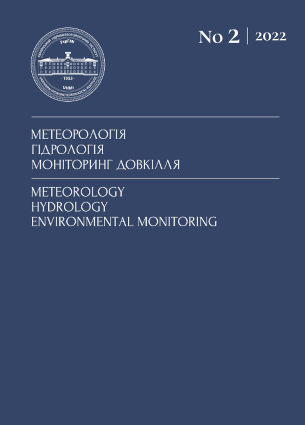HYDROMORPHOLOGICAL MONITORING OF SURFACE WATERBODIES: SURVEYPROTOCOL
Ukrainian Hydrometeorological Institute of the State Emergency Service of Ukraine and the National Academy of Sciences of Ukraine
https://orcid.org/0009-0000-4681-6433
Koshkina OlhaVitaliivna
Ukrainian Hydrometeorological Institute of the State Emergency Service of Ukraine and the National Academy of Sciences of Ukraine
https://orcid.org/0009-0006-6407-6145
Nabvvanets Yurii Bohdanovych
Ukrainian Hydrometeorological Institute of the State Emergency Service of Ukraine and the National Academy of Sciences of Ukraine
https://orcid.org/0000-0001-7443-2007
Maslova Tetiana Vsevolodivna
Ukrainian Hydrometeorological Institute of the State Emergency Service of Ukraine and the National Academy of Sciences of Ukraine
https://orcid.org/0009-0000-6184-9831
Koshkin Kyryl Volodymyrovych
Ukrainian Hydrometeorological Institute of the State Emergency Service of Ukraine and the National Academy of Sciences of Ukraine
https://orcid.org/
Abstract
References
1. Danko, K.Yu., Obodovskyi, O.H., Konovalenko, O.S. (2014). Stir River Basin water bodies and their hydromorphological status. Physical geography and geomorphology. Iss. 1. 73-89 [In Ukrainian]
2. Law of Ukraine 'On amendments to some legislative acts of Ukraine concerning the implementation of integrated approaches to water resources management by river basin principle' [In Ukrainian]
3. Obodovskyi, O.H., Rozlach, Z.V., Yaroshevych, O.Ye. (2014). Hydromorphological assessment of identified surface water bodies in-between of the Tisza and Tura rivers: methodological recommendation. Kyiv. 69 p. [In Ukrainian]
4. Obodovskyi, Yu.O., Khilchevskyi, V.K., Obodovskyi, O.H. (2018). Hydromorphoecological assessment of the river bed processes of rivers in the upper Tisza river basin (within Ukraine). Monograph. Ed. O.H. Obodovskyi. Kyiv. 193 p. [In Ukrainian]
5. Obodovskyi, Yu.O., Khilchevskyi, V.K., Obodovskyi, O.H., Konovalenko, O.S. (2016). Hydromorphological status of the rivers of the upper parts of the Tisza River Basin (within Ukraine). Hydrology, hydrochemistry and hydroecology. V.4(43). 38-53 [In Ukrainian]
6. Order of the Cabinet of Ministers of Ukraine No. 758 “On Approval of the Procedure for State Water Monitoring” of September 19, 2018 [In Ukrainian]
7. Hoffmann, M., RakovV. (2006). Determination of the ecological state of small rivers within Kyiv in accordance with the European Water Framework Directive. Hydrobiological Journal. 42, 5, 46-56][In Russian]
8. Birk, S. (2003). Overview of biological and hydromorphological assessment methods in the Danube River Basin. UNDP GEF Danube Regional Project 'Strengthening the Implementation Capacities for Nutrient Reduction and Transboundary Cooperation in the Danube River Basin. Implementing Ecological Status Assessment in line with requirements of EU Water Framework Directive using Specific Bio-Indicators': Final Report, Institut für Wassergüte, Ressourcen management und Abfallwirtschaft, Vienna: [s. l.], 60 p.
9. CEN 2010. Comité Européen de Normalisation (European Standards Agency). Water Quality – Guidance Standard on determining the degree of modification of river hydromorphology. EN15843:2010:E, 28.
10. CEN 2004. Comité Européen de Normalisation (European Standards Agency). Water Quality – Guidance standard for assessing the hydromorphological features of rivers. EN14614, 21.
11. Demek, J., Vatolikova, Z., Mackovcin, P. (2006). Manual pro sledovani hydromorfologicych slozek ecoligickeho stavutekoucich vod. Agentura ochrany prirody a krajiny ČR, Brno, 18 p.
12. Flеischhacer, T., Kern, K. (2000). Eсomorphological Survey of Large Rivers. Hamburg: German Ins. оf Hydrology, 32 p.
13. Grbovic, J. (1999). Water quality monitoring in Slovenia. Tutzing: Deutsche Gesellschaft für Limnologie, 43 p.
14. Guideline for Hydromorphological monitoring and assessment of rivers in Croatia. (2013). 92p.
15. Hoffmann, M., Saliuk, A.F. (2016). Hydromorphological assessment satthe Irpin river – methodological hintsand first findings. Меліорація і водне господарство. Вип. 106. С. 3-9.
16. Lehotsky, M., Greskova, A. (2004). Priprava databazy hydromorfologickych a biologickych ukazovatel´ov pre process vybern a charakterizacie referencnych miest podl’a Smernice 2000/60/EC: Reportto SHMI, Bratislava: Slovensky hydromet. ustav, 45 p.
17. Makovinska, J. (2000). Review of the Bioindicators Study in Yugoslavia, Development of a Preliminary Set of Danube River Basin Ecosystem Indicators, Preparation of a Concept for Monitoring Ecological Status of Significant Impact Areas and Wetlands: Report, Bratislava: Water Research Institute, 34 p.
18. Morten Lauge Pedersen, Niels Bering Ovesen, Nikolai Friberg, Bente Clausen, Milan Lehotský, Anna Grešková. (2005). Hydromorphological assessment protocol for the Slovak Republic. 36 p.
19. National water monitoring strategy. REC for Central and Eastern Europe. Country Office Serbia and Montenegro. Tripkovic D. (ed.), Belgrade: Federal Hydrometeorological Institute, 2003, 98 p.
20. Water Framework Directive (WFD) 2000/60/EC. Directive of the European Parliament and of the Council of 23 October 2000 establishing a framework for Community action in the field of water policy, EUR-Lex. URL: https://eur-lex.europa.eu/resource.html?uri=cellar:5c835afb-2ec6-4577-bdf8-756d3d694eeb.0004.02/ DOC_1&format=PDF

